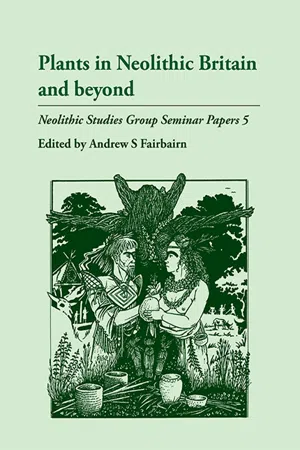
- 210 pages
- English
- PDF
- Available on iOS & Android
eBook - PDF
Plants in Neolithic Britain and Beyond
About this book
Plant-centred issues are fundamental in the definitions and explanations of the Neolithic as a phenomenon.The meeting of the Neolithic Studies Group from which this volume developed aimed to provide a forum for the wide range of approaches now applied to Neolithic archaeobotany at site and landscape scales of resolution.
Frequently asked questions
Yes, you can cancel anytime from the Subscription tab in your account settings on the Perlego website. Your subscription will stay active until the end of your current billing period. Learn how to cancel your subscription.
At the moment all of our mobile-responsive ePub books are available to download via the app. Most of our PDFs are also available to download and we're working on making the final remaining ones downloadable now. Learn more here.
Perlego offers two plans: Essential and Complete
- Essential is ideal for learners and professionals who enjoy exploring a wide range of subjects. Access the Essential Library with 800,000+ trusted titles and best-sellers across business, personal growth, and the humanities. Includes unlimited reading time and Standard Read Aloud voice.
- Complete: Perfect for advanced learners and researchers needing full, unrestricted access. Unlock 1.4M+ books across hundreds of subjects, including academic and specialized titles. The Complete Plan also includes advanced features like Premium Read Aloud and Research Assistant.
We are an online textbook subscription service, where you can get access to an entire online library for less than the price of a single book per month. With over 1 million books across 1000+ topics, we’ve got you covered! Learn more here.
Look out for the read-aloud symbol on your next book to see if you can listen to it. The read-aloud tool reads text aloud for you, highlighting the text as it is being read. You can pause it, speed it up and slow it down. Learn more here.
Yes! You can use the Perlego app on both iOS or Android devices to read anytime, anywhere — even offline. Perfect for commutes or when you’re on the go.
Please note we cannot support devices running on iOS 13 and Android 7 or earlier. Learn more about using the app.
Please note we cannot support devices running on iOS 13 and Android 7 or earlier. Learn more about using the app.
Yes, you can access Plants in Neolithic Britain and Beyond by Andrew S. Fairbairn in PDF and/or ePUB format, as well as other popular books in Social Sciences & Ancient History. We have over one million books available in our catalogue for you to explore.
Information
Table of contents
- Foreword
- Preface and acknowledgements
- List of contributors
- 1 Bringing plants into the taskscape
- 2 High resolution mapping of Neolithic and Bronze Age chalkland landscapes and landuse: The combination of multiple palaeoenvironmental analyses and topgraphic modelling
- 3 Coleopteran evidence for the Elm Decline, Neolithic activity in woodland, clearance and the use of the landscape
- 4 Plants by proxy: Plant resources on a Neolithic crannog as indicated by insect remains
- 5 Floodplain vegetation history: Clearings as potential ritual spaces?
- 6 The emperor's new garden: Woodland, trees, and people in the Neolithic of southern Britain
- 7 Evaluating the importance of cultivation and collecting in Neolithic Britain
- 8 Further considerations of Neolithic charred cereals, fruit and nuts
- 9 Revising the wheat crops of Neolithic Britain
- 10 The Neolithization of the Netherlands: Two ways, one result
- 11 On the spread of plant crops across Neolithic Britain, with special reference to southern England
- 12 Human consumption of plant foods in the British Neolithic: Direct evidence from bone stable isotopes
- 13 Neolithic ale: Barley as a source of malt sugars for fermentation
- 14 Plants as the raw materials for crafts
- 15 The altering eye: Reconstructing archaeobotany
- Bibliography